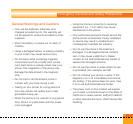
27
Emergency Services and Safety Precautions
12. Where can I find additional
information?
For additional information, please refer to the
following resources:
FDA web page on wireless phones
(http://www.fda.gov/cdrh/phones/index.html)
Federal Communications Commission (FCC) RF
Safety Program
(http://www.fcc.gov/oet/rfsafety)
International Commission on Non-lonizing
Radiation Protection (http://www.icnirp.de)
World Health Organization (WHO) International
EMF Project (http://www.who.int/emf)
National Radiological Protection Board (UK)
(http://www.nrpb.org.uk/)
10 Driver Safety Tips
Your wireless phone gives you the powerful
ability to communicate by voice almost
anywhere, anytime. An important responsibility
accompanies the benefits of wireless phones,
one that every user must uphold.
When operating a car, driving is your first
responsibility. When using your wireless phone
behind the wheel of a car, practice good
common sense and remember the following
tips:
1. Get to know your wireless phone and its
features such as speed dial and redial.
Carefully read your instruction manual and
learn to take advantage of valuable features
most phones offer, including automatic redial
and memory. Also, work to memorize the
phone keypad so you can use the speed dial
function without taking your attention off the
road.
2. When available, use a hands-free device. A
number of hands-free wireless phone
accessories are readily available today.
Whether you choose an installed mounted
device for your wireless phone or a speaker
phone accessory, take advantage of these
devices if available to you.
3. Position your wireless phone within easy
reach. Make sure you place your wireless
phone within easy reach and where you can
reach it without removing your eyes from the
road. If you get an incoming call at an
inconvenient time, if possible, let your
voicemail answer it for you.


















